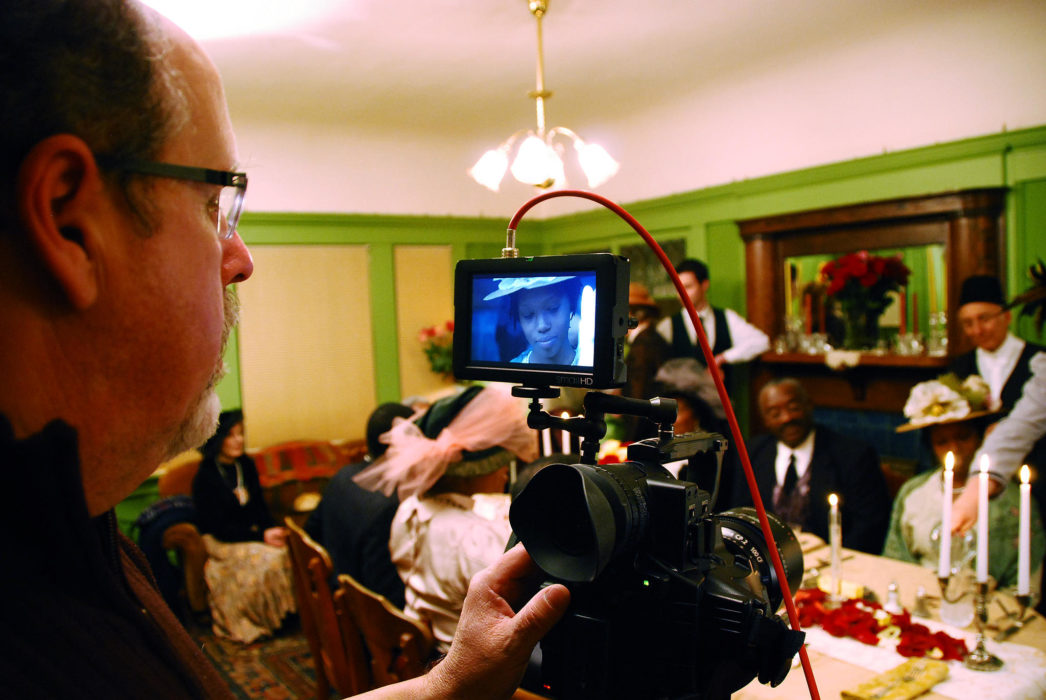FOR THE PAST FIVE years, Anne Perry and her husband Tim have been working on a feature-length documentary film chronicling ‘Abdu’l-Bahá’s 1912 journey through the United States and Canada. I recently had the chance to interview Anne about the film.
RS: Tell me about the genesis of the film.
AP: My husband and I were drawn together because of our mutual interest in artistic expression. I’m not sure when the idea was born to do a feature-length film about the journey of ‘Abdu’l-Bahá to America, but I know that for decades we have both had a special feeling about the centenary year. In 2007 we went to Washington, DC, for our first location scouting. Then the research and writing phase began. A major challenge was choosing the most essential things to put into the script, which meant shortening the initial eight-hour version down to ninety minutes. We began shooting in June 2011, in Colorado.
RS: What are your goals for the project?
AP: To give a sense of what it was like to meet ‘Abdu’l-Bahá in 1912, and of course to celebrate the centenary of a moment in history with astonishing aspects and ramifications. The visit of ‘Abdu’l-Bahá to the United States and Canada is part of history — little known, but nonetheless incredibly important. It is larger and more complex than any single story can portray or even suggest. But we hope we can capture enough to help people understand that it contains inspiration to impel us to live differently.

RS: I understand that you have logged quite a few miles over the past year.
AP: We’ve shot in about twenty locations across North America. The list includes Baltimore; New York; New Jersey; Lake Mohonk; Washington, DC; Green Acre in Eliot, Maine; Dublin, New Hampshire; Boston, Malden, and Brookline in Massachusetts; Philadelphia; Montreal; Chicago; Colorado; and the San Francisco Bay area. We recreated a few locations in Texas and Florida. We’ve been incredibly blessed with hospitality and assistance.
RS: What stories have you found most compelling?
AP: One of the most vibrant and beautiful scenes we’ve shot depicts the banquet honoring African Americans after they were excluded from ‘Abdu’l-Bahá’s farewell dinner at the Great Northern Hotel by the hotel’s proprietor. They are being served by white women at the Kinney home. The scene takes place in New York, but we actually shot it in Berkeley, California. We know from the historical record that it pleased ‘Abdu’l-Bahá greatly to have such evidence of unity.
A particularly touching moment was the scene with Fred Mortensen, a poor man who had ridden the rods to Green Acre. We were shooting late at night. We had extras in the lobby representing society people, and Fred standing there with dirt on his shirt and hat. In ‘Abdu’l-Bahá’s room, we seated Fred across from where we imagined ‘Abdu’l-Bahá would have been, and focused on Fred’s eyes. At one point, Fred holds out his dirty hat to the camera, and the narrator will describe how ‘Abdu’l-Bahá kissed it. Since the walls and floor are very thin, a guest came up to complain that he couldn’t sleep. We were mortified! But he realized the scene was important. I think that everyone who hears Fred’s story is touched by it.
We shot a scene at the Bowery Mission in New York that came about in an unexpected way. After some confusion over the Bowery address, we found ourselves giving a gentleman named James a ride from the corporate headquarters of the Bowery, to the Bowery itself. James was one of the mission’s trustees, and soon every door was opened to us. He arranged for us to shoot inside the chapel and to meet the Chaplain, who gives three services a day there. It was quite a profound sensation — we truly felt and could imagine the presence of ‘Abdu’l-Bahá, Juliet Thompson, the journalist Kate Carew, and the impoverished men that ‘Abdu’l-Bahá spoke to in that narrow chapel.
RS: Have there been any unexpected moments?
AP: At the White mansion in Brookline, Massachusetts, where ‘Abdu’l-Bahá spoke, a caretaker came out and told us that he had been keeping the grounds beautiful because he knew the Bahá’ís would want to come back sometime to hold a commemoration. He even pointed out to us where ‘Abdu’l-Bahá stood.
RS: What are the various roles you and your husband play?
AP: Tim and I are co-producing. Tim’s directing and editing, and was responsible for most of the cinematography. I wrote the script along with Gary Lindberg, have acted in a few roles, and worked with Laurie Eley on the costume design.

RS: Dare I ask what it’s like working on a film for such a long and intense period of time with your spouse?
AP: Creating a work with one’s spouse can be a huge challenge. In many film productions the writer passes on the script to the producer or director, who then does as he/she will with it. In our case, we are co-producers. I am the kind of writer who wants to make collaborative decisions, where Tim simply wants to re-arrange and cut without consultation! And of course there are times we are at odds over what to depict, which music to use, and so forth.
But it truly does represent the fruit of our lives. It is a true product of our marriage, and something that neither of us could do without the other.






